A Review of Highly Skilled Migrants, Migration from India to UK
VerifiedAdded on 2020/02/05
|11
|3958
|60
Literature Review
AI Summary
This literature review explores the multifaceted topic of highly skilled migration, with a specific focus on the movement of skilled workers from India to the United Kingdom. The review delves into the definition and characteristics of highly skilled migrants, highlighting the importance of their education, qualifications, and contribution to economic development. It examines various push and pull factors influencing migration, including economic opportunities, quality of life, and political stability. The review also analyzes the impact of migration on both the sending and receiving countries, addressing issues such as brain drain, cultural adaptation, and economic growth. Furthermore, it discusses the migration patterns of Indians, their integration into the UK, and the historical context of Indian migration. The literature review also touches upon the challenges faced by migrants, including cultural shocks and social integration, as well as the immigration policies implemented by different countries to attract skilled labor. Overall, the review provides a comprehensive overview of the key themes and debates surrounding highly skilled migration from India to the UK, drawing on a range of academic sources and research findings.
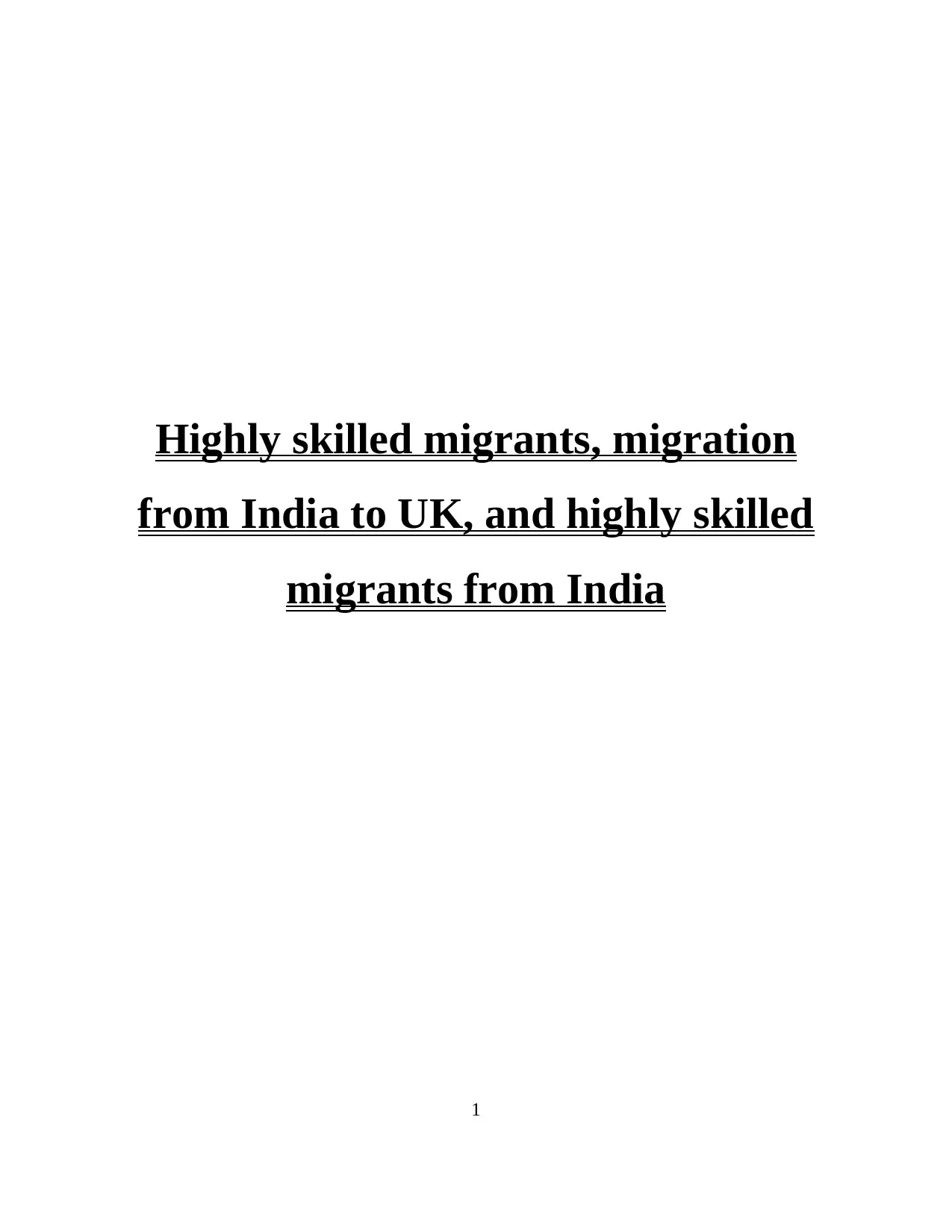
Highly skilled migrants, migration
from India to UK, and highly skilled
migrants from India
1
from India to UK, and highly skilled
migrants from India
1
Paraphrase This Document
Need a fresh take? Get an instant paraphrase of this document with our AI Paraphraser
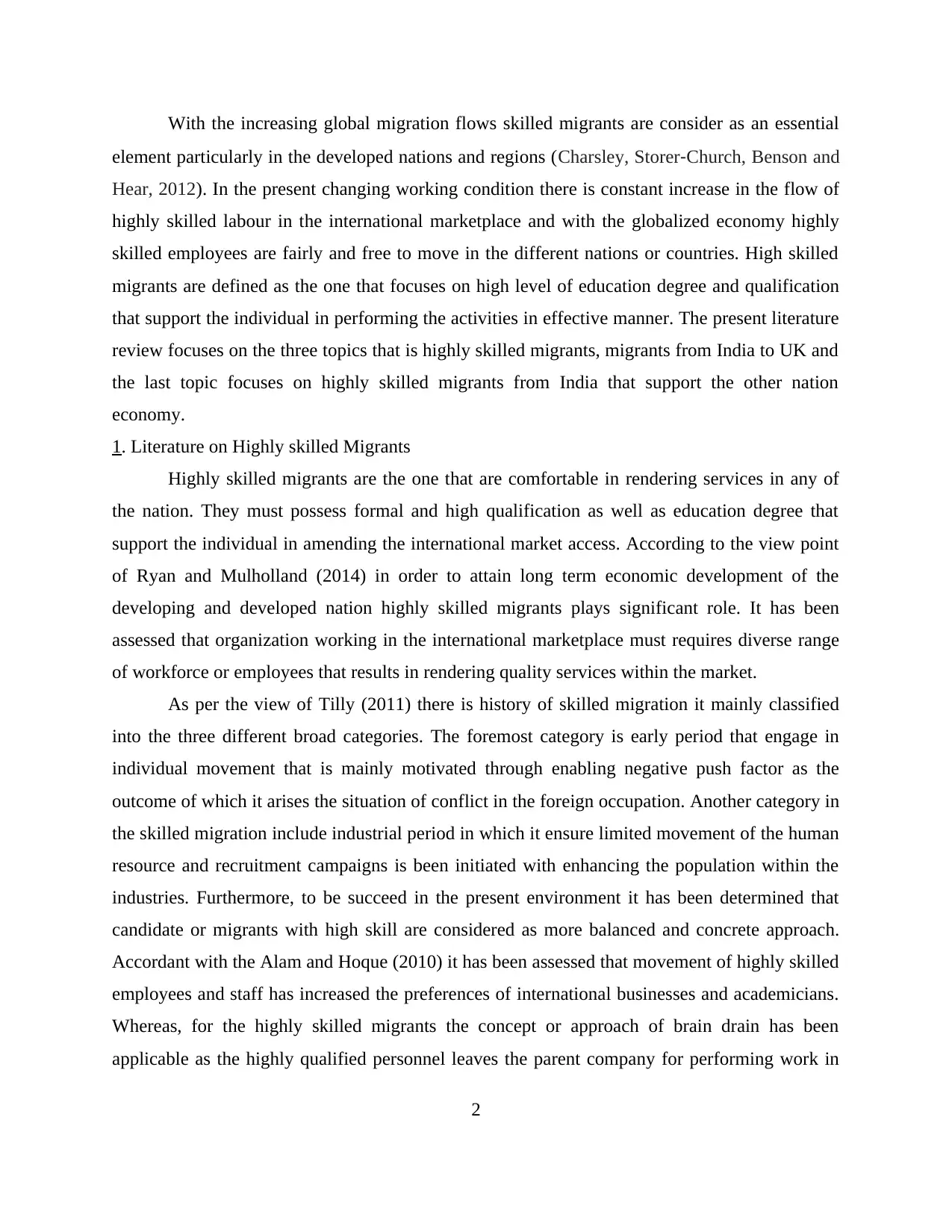
With the increasing global migration flows skilled migrants are consider as an essential
element particularly in the developed nations and regions (Charsley, Storer‐Church, Benson and
Hear, 2012). In the present changing working condition there is constant increase in the flow of
highly skilled labour in the international marketplace and with the globalized economy highly
skilled employees are fairly and free to move in the different nations or countries. High skilled
migrants are defined as the one that focuses on high level of education degree and qualification
that support the individual in performing the activities in effective manner. The present literature
review focuses on the three topics that is highly skilled migrants, migrants from India to UK and
the last topic focuses on highly skilled migrants from India that support the other nation
economy.
1. Literature on Highly skilled Migrants
Highly skilled migrants are the one that are comfortable in rendering services in any of
the nation. They must possess formal and high qualification as well as education degree that
support the individual in amending the international market access. According to the view point
of Ryan and Mulholland (2014) in order to attain long term economic development of the
developing and developed nation highly skilled migrants plays significant role. It has been
assessed that organization working in the international marketplace must requires diverse range
of workforce or employees that results in rendering quality services within the market.
As per the view of Tilly (2011) there is history of skilled migration it mainly classified
into the three different broad categories. The foremost category is early period that engage in
individual movement that is mainly motivated through enabling negative push factor as the
outcome of which it arises the situation of conflict in the foreign occupation. Another category in
the skilled migration include industrial period in which it ensure limited movement of the human
resource and recruitment campaigns is been initiated with enhancing the population within the
industries. Furthermore, to be succeed in the present environment it has been determined that
candidate or migrants with high skill are considered as more balanced and concrete approach.
Accordant with the Alam and Hoque (2010) it has been assessed that movement of highly skilled
employees and staff has increased the preferences of international businesses and academicians.
Whereas, for the highly skilled migrants the concept or approach of brain drain has been
applicable as the highly qualified personnel leaves the parent company for performing work in
2
element particularly in the developed nations and regions (Charsley, Storer‐Church, Benson and
Hear, 2012). In the present changing working condition there is constant increase in the flow of
highly skilled labour in the international marketplace and with the globalized economy highly
skilled employees are fairly and free to move in the different nations or countries. High skilled
migrants are defined as the one that focuses on high level of education degree and qualification
that support the individual in performing the activities in effective manner. The present literature
review focuses on the three topics that is highly skilled migrants, migrants from India to UK and
the last topic focuses on highly skilled migrants from India that support the other nation
economy.
1. Literature on Highly skilled Migrants
Highly skilled migrants are the one that are comfortable in rendering services in any of
the nation. They must possess formal and high qualification as well as education degree that
support the individual in amending the international market access. According to the view point
of Ryan and Mulholland (2014) in order to attain long term economic development of the
developing and developed nation highly skilled migrants plays significant role. It has been
assessed that organization working in the international marketplace must requires diverse range
of workforce or employees that results in rendering quality services within the market.
As per the view of Tilly (2011) there is history of skilled migration it mainly classified
into the three different broad categories. The foremost category is early period that engage in
individual movement that is mainly motivated through enabling negative push factor as the
outcome of which it arises the situation of conflict in the foreign occupation. Another category in
the skilled migration include industrial period in which it ensure limited movement of the human
resource and recruitment campaigns is been initiated with enhancing the population within the
industries. Furthermore, to be succeed in the present environment it has been determined that
candidate or migrants with high skill are considered as more balanced and concrete approach.
Accordant with the Alam and Hoque (2010) it has been assessed that movement of highly skilled
employees and staff has increased the preferences of international businesses and academicians.
Whereas, for the highly skilled migrants the concept or approach of brain drain has been
applicable as the highly qualified personnel leaves the parent company for performing work in
2
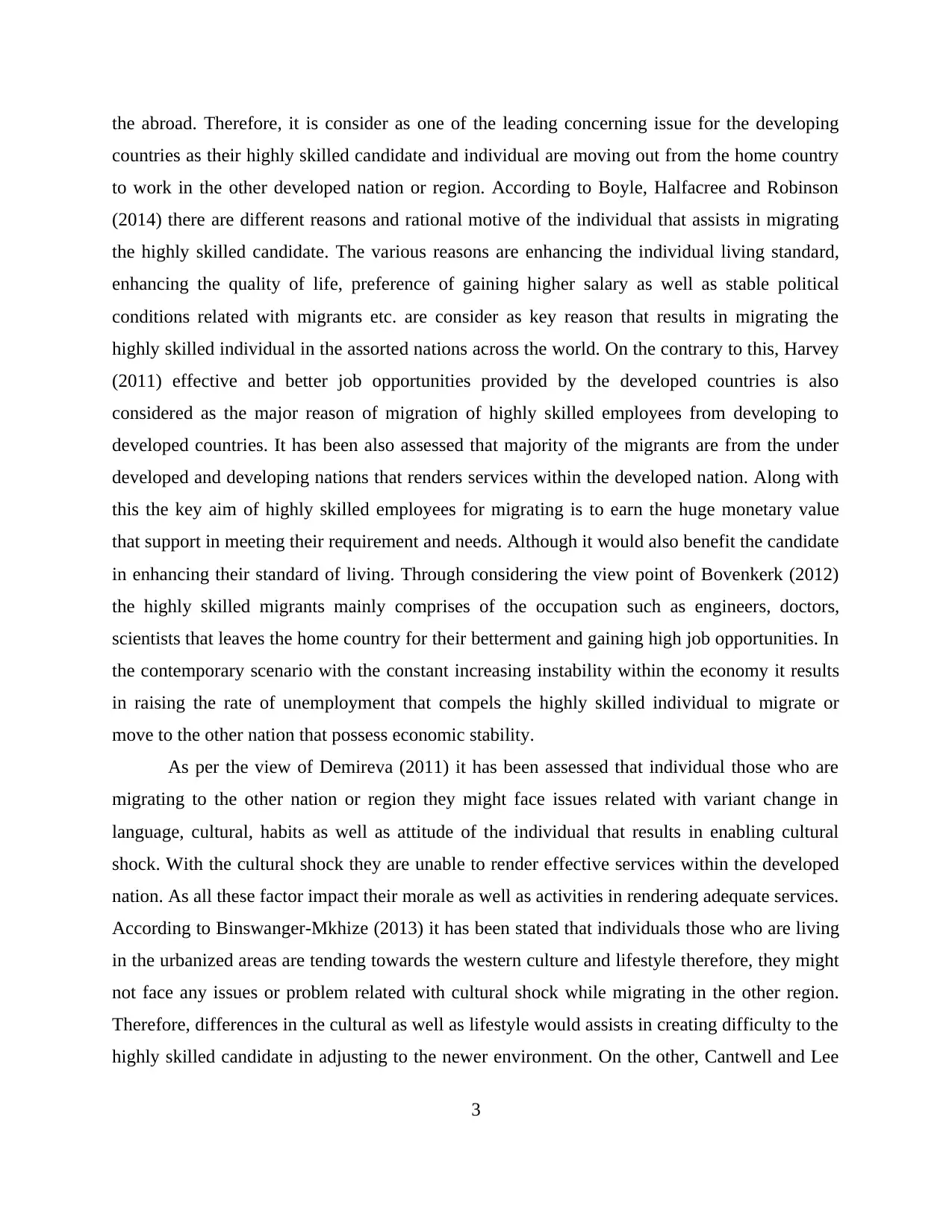
the abroad. Therefore, it is consider as one of the leading concerning issue for the developing
countries as their highly skilled candidate and individual are moving out from the home country
to work in the other developed nation or region. According to Boyle, Halfacree and Robinson
(2014) there are different reasons and rational motive of the individual that assists in migrating
the highly skilled candidate. The various reasons are enhancing the individual living standard,
enhancing the quality of life, preference of gaining higher salary as well as stable political
conditions related with migrants etc. are consider as key reason that results in migrating the
highly skilled individual in the assorted nations across the world. On the contrary to this, Harvey
(2011) effective and better job opportunities provided by the developed countries is also
considered as the major reason of migration of highly skilled employees from developing to
developed countries. It has been also assessed that majority of the migrants are from the under
developed and developing nations that renders services within the developed nation. Along with
this the key aim of highly skilled employees for migrating is to earn the huge monetary value
that support in meeting their requirement and needs. Although it would also benefit the candidate
in enhancing their standard of living. Through considering the view point of Bovenkerk (2012)
the highly skilled migrants mainly comprises of the occupation such as engineers, doctors,
scientists that leaves the home country for their betterment and gaining high job opportunities. In
the contemporary scenario with the constant increasing instability within the economy it results
in raising the rate of unemployment that compels the highly skilled individual to migrate or
move to the other nation that possess economic stability.
As per the view of Demireva (2011) it has been assessed that individual those who are
migrating to the other nation or region they might face issues related with variant change in
language, cultural, habits as well as attitude of the individual that results in enabling cultural
shock. With the cultural shock they are unable to render effective services within the developed
nation. As all these factor impact their morale as well as activities in rendering adequate services.
According to Binswanger-Mkhize (2013) it has been stated that individuals those who are living
in the urbanized areas are tending towards the western culture and lifestyle therefore, they might
not face any issues or problem related with cultural shock while migrating in the other region.
Therefore, differences in the cultural as well as lifestyle would assists in creating difficulty to the
highly skilled candidate in adjusting to the newer environment. On the other, Cantwell and Lee
3
countries as their highly skilled candidate and individual are moving out from the home country
to work in the other developed nation or region. According to Boyle, Halfacree and Robinson
(2014) there are different reasons and rational motive of the individual that assists in migrating
the highly skilled candidate. The various reasons are enhancing the individual living standard,
enhancing the quality of life, preference of gaining higher salary as well as stable political
conditions related with migrants etc. are consider as key reason that results in migrating the
highly skilled individual in the assorted nations across the world. On the contrary to this, Harvey
(2011) effective and better job opportunities provided by the developed countries is also
considered as the major reason of migration of highly skilled employees from developing to
developed countries. It has been also assessed that majority of the migrants are from the under
developed and developing nations that renders services within the developed nation. Along with
this the key aim of highly skilled employees for migrating is to earn the huge monetary value
that support in meeting their requirement and needs. Although it would also benefit the candidate
in enhancing their standard of living. Through considering the view point of Bovenkerk (2012)
the highly skilled migrants mainly comprises of the occupation such as engineers, doctors,
scientists that leaves the home country for their betterment and gaining high job opportunities. In
the contemporary scenario with the constant increasing instability within the economy it results
in raising the rate of unemployment that compels the highly skilled individual to migrate or
move to the other nation that possess economic stability.
As per the view of Demireva (2011) it has been assessed that individual those who are
migrating to the other nation or region they might face issues related with variant change in
language, cultural, habits as well as attitude of the individual that results in enabling cultural
shock. With the cultural shock they are unable to render effective services within the developed
nation. As all these factor impact their morale as well as activities in rendering adequate services.
According to Binswanger-Mkhize (2013) it has been stated that individuals those who are living
in the urbanized areas are tending towards the western culture and lifestyle therefore, they might
not face any issues or problem related with cultural shock while migrating in the other region.
Therefore, differences in the cultural as well as lifestyle would assists in creating difficulty to the
highly skilled candidate in adjusting to the newer environment. On the other, Cantwell and Lee
3
⊘ This is a preview!⊘
Do you want full access?
Subscribe today to unlock all pages.

Trusted by 1+ million students worldwide
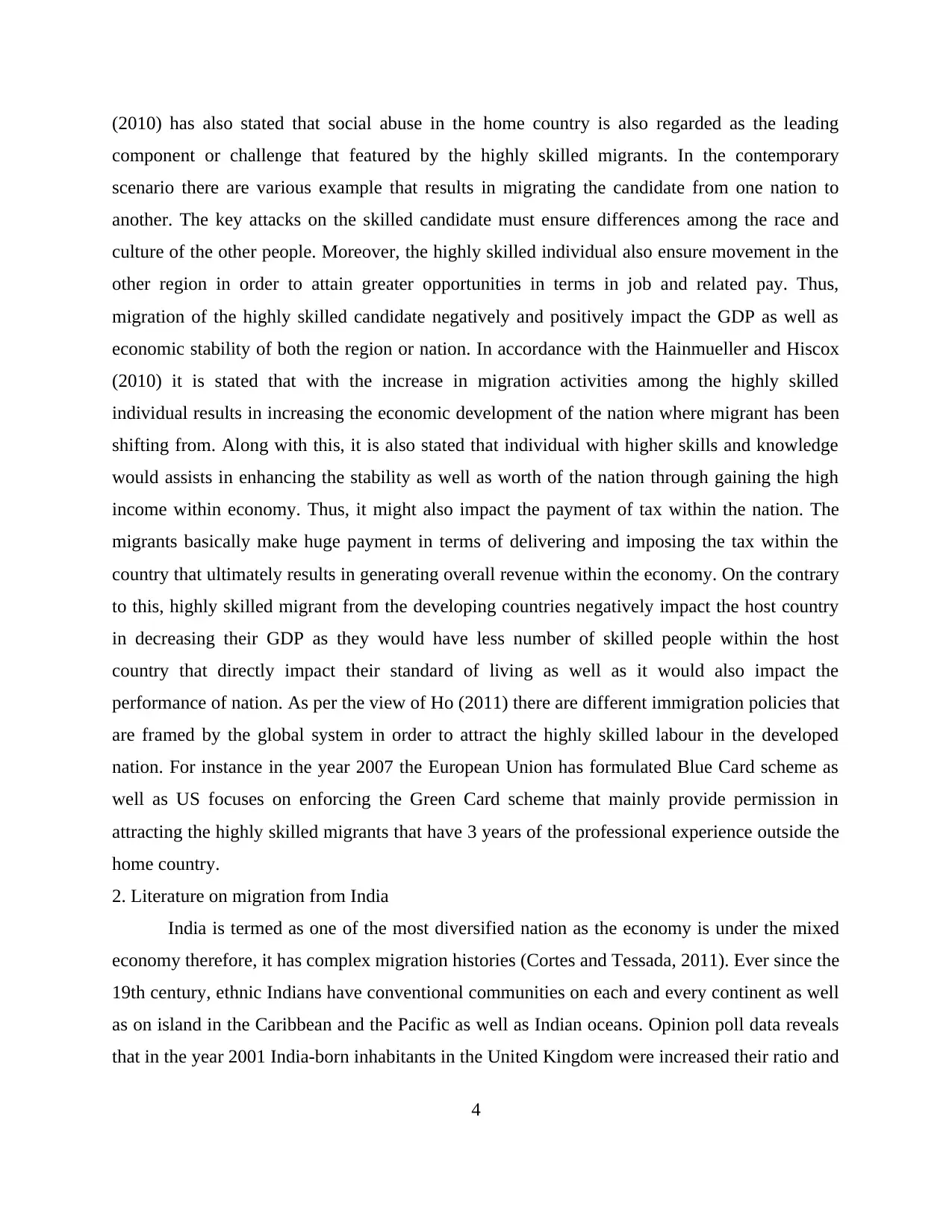
(2010) has also stated that social abuse in the home country is also regarded as the leading
component or challenge that featured by the highly skilled migrants. In the contemporary
scenario there are various example that results in migrating the candidate from one nation to
another. The key attacks on the skilled candidate must ensure differences among the race and
culture of the other people. Moreover, the highly skilled individual also ensure movement in the
other region in order to attain greater opportunities in terms in job and related pay. Thus,
migration of the highly skilled candidate negatively and positively impact the GDP as well as
economic stability of both the region or nation. In accordance with the Hainmueller and Hiscox
(2010) it is stated that with the increase in migration activities among the highly skilled
individual results in increasing the economic development of the nation where migrant has been
shifting from. Along with this, it is also stated that individual with higher skills and knowledge
would assists in enhancing the stability as well as worth of the nation through gaining the high
income within economy. Thus, it might also impact the payment of tax within the nation. The
migrants basically make huge payment in terms of delivering and imposing the tax within the
country that ultimately results in generating overall revenue within the economy. On the contrary
to this, highly skilled migrant from the developing countries negatively impact the host country
in decreasing their GDP as they would have less number of skilled people within the host
country that directly impact their standard of living as well as it would also impact the
performance of nation. As per the view of Ho (2011) there are different immigration policies that
are framed by the global system in order to attract the highly skilled labour in the developed
nation. For instance in the year 2007 the European Union has formulated Blue Card scheme as
well as US focuses on enforcing the Green Card scheme that mainly provide permission in
attracting the highly skilled migrants that have 3 years of the professional experience outside the
home country.
2. Literature on migration from India
India is termed as one of the most diversified nation as the economy is under the mixed
economy therefore, it has complex migration histories (Cortes and Tessada, 2011). Ever since the
19th century, ethnic Indians have conventional communities on each and every continent as well
as on island in the Caribbean and the Pacific as well as Indian oceans. Opinion poll data reveals
that in the year 2001 India-born inhabitants in the United Kingdom were increased their ratio and
4
component or challenge that featured by the highly skilled migrants. In the contemporary
scenario there are various example that results in migrating the candidate from one nation to
another. The key attacks on the skilled candidate must ensure differences among the race and
culture of the other people. Moreover, the highly skilled individual also ensure movement in the
other region in order to attain greater opportunities in terms in job and related pay. Thus,
migration of the highly skilled candidate negatively and positively impact the GDP as well as
economic stability of both the region or nation. In accordance with the Hainmueller and Hiscox
(2010) it is stated that with the increase in migration activities among the highly skilled
individual results in increasing the economic development of the nation where migrant has been
shifting from. Along with this, it is also stated that individual with higher skills and knowledge
would assists in enhancing the stability as well as worth of the nation through gaining the high
income within economy. Thus, it might also impact the payment of tax within the nation. The
migrants basically make huge payment in terms of delivering and imposing the tax within the
country that ultimately results in generating overall revenue within the economy. On the contrary
to this, highly skilled migrant from the developing countries negatively impact the host country
in decreasing their GDP as they would have less number of skilled people within the host
country that directly impact their standard of living as well as it would also impact the
performance of nation. As per the view of Ho (2011) there are different immigration policies that
are framed by the global system in order to attract the highly skilled labour in the developed
nation. For instance in the year 2007 the European Union has formulated Blue Card scheme as
well as US focuses on enforcing the Green Card scheme that mainly provide permission in
attracting the highly skilled migrants that have 3 years of the professional experience outside the
home country.
2. Literature on migration from India
India is termed as one of the most diversified nation as the economy is under the mixed
economy therefore, it has complex migration histories (Cortes and Tessada, 2011). Ever since the
19th century, ethnic Indians have conventional communities on each and every continent as well
as on island in the Caribbean and the Pacific as well as Indian oceans. Opinion poll data reveals
that in the year 2001 India-born inhabitants in the United Kingdom were increased their ratio and
4
Paraphrase This Document
Need a fresh take? Get an instant paraphrase of this document with our AI Paraphraser
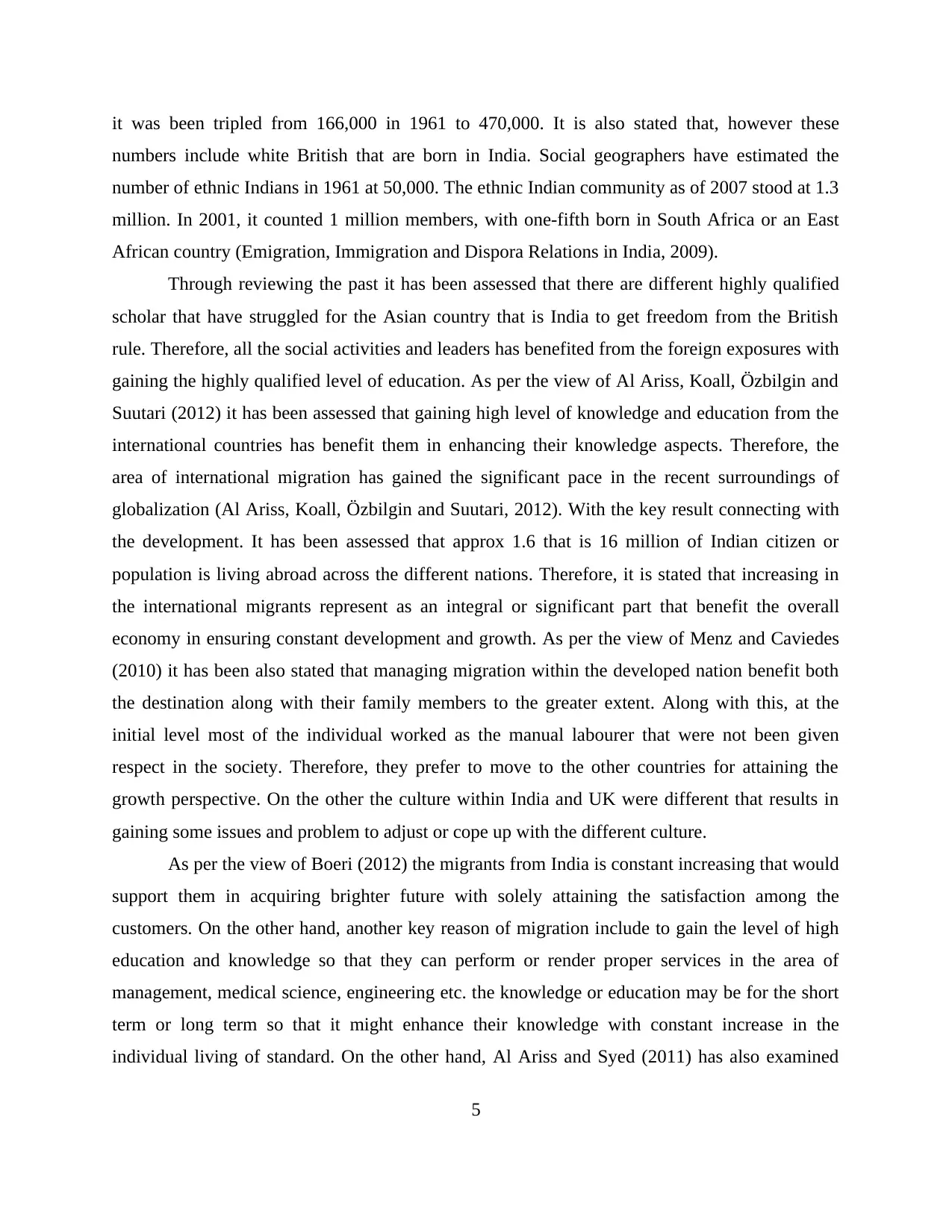
it was been tripled from 166,000 in 1961 to 470,000. It is also stated that, however these
numbers include white British that are born in India. Social geographers have estimated the
number of ethnic Indians in 1961 at 50,000. The ethnic Indian community as of 2007 stood at 1.3
million. In 2001, it counted 1 million members, with one-fifth born in South Africa or an East
African country (Emigration, Immigration and Dispora Relations in India, 2009).
Through reviewing the past it has been assessed that there are different highly qualified
scholar that have struggled for the Asian country that is India to get freedom from the British
rule. Therefore, all the social activities and leaders has benefited from the foreign exposures with
gaining the highly qualified level of education. As per the view of Al Ariss, Koall, Özbilgin and
Suutari (2012) it has been assessed that gaining high level of knowledge and education from the
international countries has benefit them in enhancing their knowledge aspects. Therefore, the
area of international migration has gained the significant pace in the recent surroundings of
globalization (Al Ariss, Koall, Özbilgin and Suutari, 2012). With the key result connecting with
the development. It has been assessed that approx 1.6 that is 16 million of Indian citizen or
population is living abroad across the different nations. Therefore, it is stated that increasing in
the international migrants represent as an integral or significant part that benefit the overall
economy in ensuring constant development and growth. As per the view of Menz and Caviedes
(2010) it has been also stated that managing migration within the developed nation benefit both
the destination along with their family members to the greater extent. Along with this, at the
initial level most of the individual worked as the manual labourer that were not been given
respect in the society. Therefore, they prefer to move to the other countries for attaining the
growth perspective. On the other the culture within India and UK were different that results in
gaining some issues and problem to adjust or cope up with the different culture.
As per the view of Boeri (2012) the migrants from India is constant increasing that would
support them in acquiring brighter future with solely attaining the satisfaction among the
customers. On the other hand, another key reason of migration include to gain the level of high
education and knowledge so that they can perform or render proper services in the area of
management, medical science, engineering etc. the knowledge or education may be for the short
term or long term so that it might enhance their knowledge with constant increase in the
individual living of standard. On the other hand, Al Ariss and Syed (2011) has also examined
5
numbers include white British that are born in India. Social geographers have estimated the
number of ethnic Indians in 1961 at 50,000. The ethnic Indian community as of 2007 stood at 1.3
million. In 2001, it counted 1 million members, with one-fifth born in South Africa or an East
African country (Emigration, Immigration and Dispora Relations in India, 2009).
Through reviewing the past it has been assessed that there are different highly qualified
scholar that have struggled for the Asian country that is India to get freedom from the British
rule. Therefore, all the social activities and leaders has benefited from the foreign exposures with
gaining the highly qualified level of education. As per the view of Al Ariss, Koall, Özbilgin and
Suutari (2012) it has been assessed that gaining high level of knowledge and education from the
international countries has benefit them in enhancing their knowledge aspects. Therefore, the
area of international migration has gained the significant pace in the recent surroundings of
globalization (Al Ariss, Koall, Özbilgin and Suutari, 2012). With the key result connecting with
the development. It has been assessed that approx 1.6 that is 16 million of Indian citizen or
population is living abroad across the different nations. Therefore, it is stated that increasing in
the international migrants represent as an integral or significant part that benefit the overall
economy in ensuring constant development and growth. As per the view of Menz and Caviedes
(2010) it has been also stated that managing migration within the developed nation benefit both
the destination along with their family members to the greater extent. Along with this, at the
initial level most of the individual worked as the manual labourer that were not been given
respect in the society. Therefore, they prefer to move to the other countries for attaining the
growth perspective. On the other the culture within India and UK were different that results in
gaining some issues and problem to adjust or cope up with the different culture.
As per the view of Boeri (2012) the migrants from India is constant increasing that would
support them in acquiring brighter future with solely attaining the satisfaction among the
customers. On the other hand, another key reason of migration include to gain the level of high
education and knowledge so that they can perform or render proper services in the area of
management, medical science, engineering etc. the knowledge or education may be for the short
term or long term so that it might enhance their knowledge with constant increase in the
individual living of standard. On the other hand, Al Ariss and Syed (2011) has also examined
5
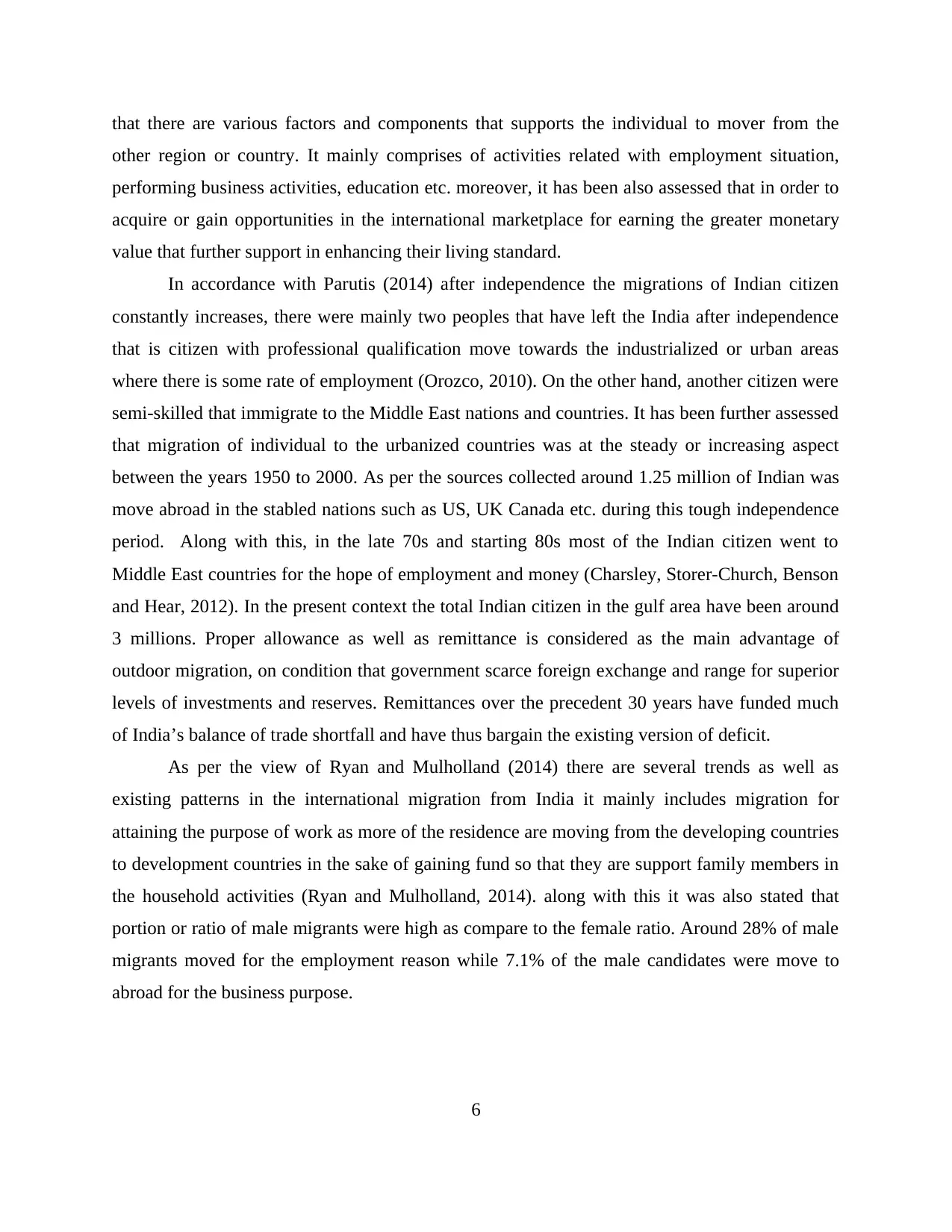
that there are various factors and components that supports the individual to mover from the
other region or country. It mainly comprises of activities related with employment situation,
performing business activities, education etc. moreover, it has been also assessed that in order to
acquire or gain opportunities in the international marketplace for earning the greater monetary
value that further support in enhancing their living standard.
In accordance with Parutis (2014) after independence the migrations of Indian citizen
constantly increases, there were mainly two peoples that have left the India after independence
that is citizen with professional qualification move towards the industrialized or urban areas
where there is some rate of employment (Orozco, 2010). On the other hand, another citizen were
semi-skilled that immigrate to the Middle East nations and countries. It has been further assessed
that migration of individual to the urbanized countries was at the steady or increasing aspect
between the years 1950 to 2000. As per the sources collected around 1.25 million of Indian was
move abroad in the stabled nations such as US, UK Canada etc. during this tough independence
period. Along with this, in the late 70s and starting 80s most of the Indian citizen went to
Middle East countries for the hope of employment and money (Charsley, Storer‐Church, Benson
and Hear, 2012). In the present context the total Indian citizen in the gulf area have been around
3 millions. Proper allowance as well as remittance is considered as the main advantage of
outdoor migration, on condition that government scarce foreign exchange and range for superior
levels of investments and reserves. Remittances over the precedent 30 years have funded much
of India’s balance of trade shortfall and have thus bargain the existing version of deficit.
As per the view of Ryan and Mulholland (2014) there are several trends as well as
existing patterns in the international migration from India it mainly includes migration for
attaining the purpose of work as more of the residence are moving from the developing countries
to development countries in the sake of gaining fund so that they are support family members in
the household activities (Ryan and Mulholland, 2014). along with this it was also stated that
portion or ratio of male migrants were high as compare to the female ratio. Around 28% of male
migrants moved for the employment reason while 7.1% of the male candidates were move to
abroad for the business purpose.
6
other region or country. It mainly comprises of activities related with employment situation,
performing business activities, education etc. moreover, it has been also assessed that in order to
acquire or gain opportunities in the international marketplace for earning the greater monetary
value that further support in enhancing their living standard.
In accordance with Parutis (2014) after independence the migrations of Indian citizen
constantly increases, there were mainly two peoples that have left the India after independence
that is citizen with professional qualification move towards the industrialized or urban areas
where there is some rate of employment (Orozco, 2010). On the other hand, another citizen were
semi-skilled that immigrate to the Middle East nations and countries. It has been further assessed
that migration of individual to the urbanized countries was at the steady or increasing aspect
between the years 1950 to 2000. As per the sources collected around 1.25 million of Indian was
move abroad in the stabled nations such as US, UK Canada etc. during this tough independence
period. Along with this, in the late 70s and starting 80s most of the Indian citizen went to
Middle East countries for the hope of employment and money (Charsley, Storer‐Church, Benson
and Hear, 2012). In the present context the total Indian citizen in the gulf area have been around
3 millions. Proper allowance as well as remittance is considered as the main advantage of
outdoor migration, on condition that government scarce foreign exchange and range for superior
levels of investments and reserves. Remittances over the precedent 30 years have funded much
of India’s balance of trade shortfall and have thus bargain the existing version of deficit.
As per the view of Ryan and Mulholland (2014) there are several trends as well as
existing patterns in the international migration from India it mainly includes migration for
attaining the purpose of work as more of the residence are moving from the developing countries
to development countries in the sake of gaining fund so that they are support family members in
the household activities (Ryan and Mulholland, 2014). along with this it was also stated that
portion or ratio of male migrants were high as compare to the female ratio. Around 28% of male
migrants moved for the employment reason while 7.1% of the male candidates were move to
abroad for the business purpose.
6
⊘ This is a preview!⊘
Do you want full access?
Subscribe today to unlock all pages.

Trusted by 1+ million students worldwide
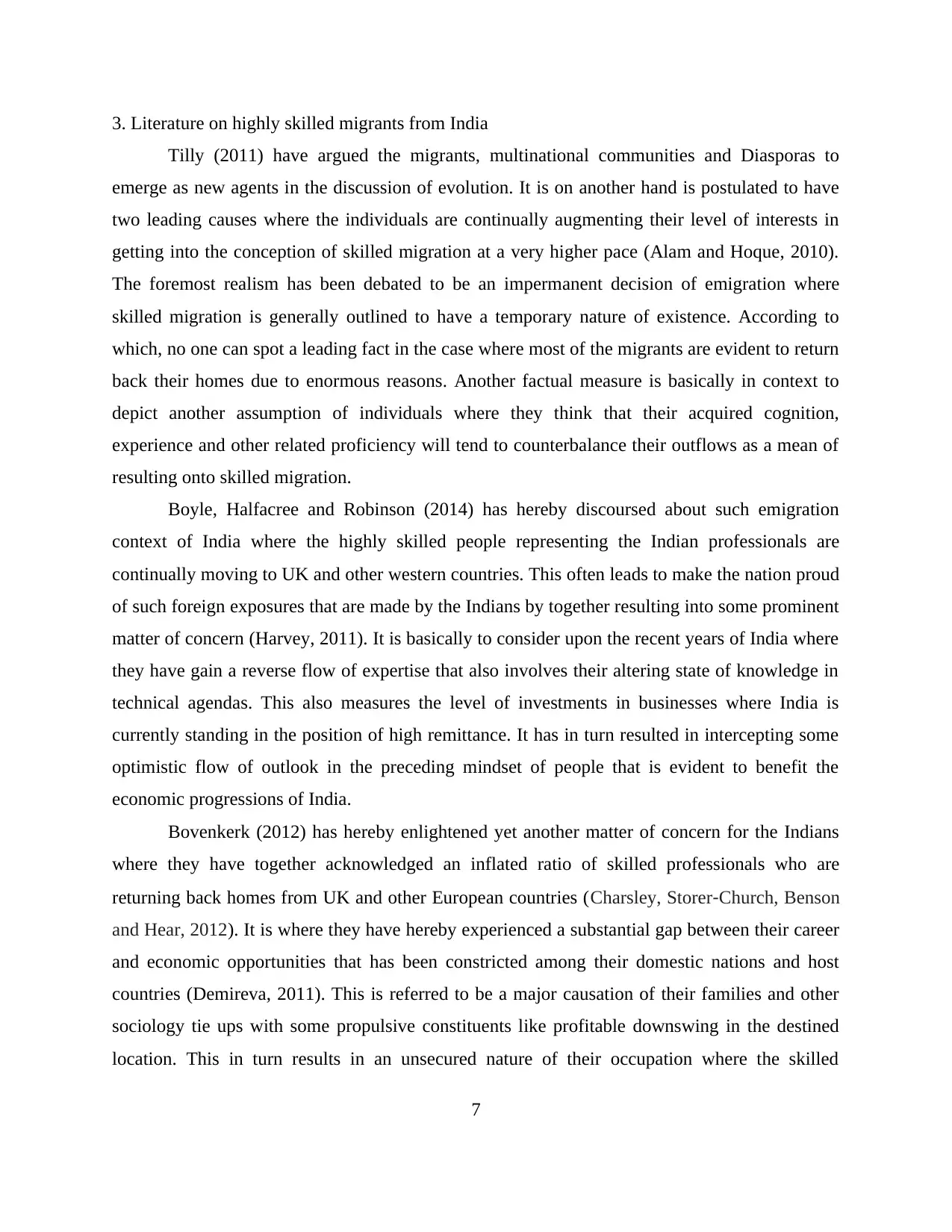
3. Literature on highly skilled migrants from India
Tilly (2011) have argued the migrants, multinational communities and Diasporas to
emerge as new agents in the discussion of evolution. It is on another hand is postulated to have
two leading causes where the individuals are continually augmenting their level of interests in
getting into the conception of skilled migration at a very higher pace (Alam and Hoque, 2010).
The foremost realism has been debated to be an impermanent decision of emigration where
skilled migration is generally outlined to have a temporary nature of existence. According to
which, no one can spot a leading fact in the case where most of the migrants are evident to return
back their homes due to enormous reasons. Another factual measure is basically in context to
depict another assumption of individuals where they think that their acquired cognition,
experience and other related proficiency will tend to counterbalance their outflows as a mean of
resulting onto skilled migration.
Boyle, Halfacree and Robinson (2014) has hereby discoursed about such emigration
context of India where the highly skilled people representing the Indian professionals are
continually moving to UK and other western countries. This often leads to make the nation proud
of such foreign exposures that are made by the Indians by together resulting into some prominent
matter of concern (Harvey, 2011). It is basically to consider upon the recent years of India where
they have gain a reverse flow of expertise that also involves their altering state of knowledge in
technical agendas. This also measures the level of investments in businesses where India is
currently standing in the position of high remittance. It has in turn resulted in intercepting some
optimistic flow of outlook in the preceding mindset of people that is evident to benefit the
economic progressions of India.
Bovenkerk (2012) has hereby enlightened yet another matter of concern for the Indians
where they have together acknowledged an inflated ratio of skilled professionals who are
returning back homes from UK and other European countries (Charsley, Storer‐Church, Benson
and Hear, 2012). It is where they have hereby experienced a substantial gap between their career
and economic opportunities that has been constricted among their domestic nations and host
countries (Demireva, 2011). This is referred to be a major causation of their families and other
sociology tie ups with some propulsive constituents like profitable downswing in the destined
location. This in turn results in an unsecured nature of their occupation where the skilled
7
Tilly (2011) have argued the migrants, multinational communities and Diasporas to
emerge as new agents in the discussion of evolution. It is on another hand is postulated to have
two leading causes where the individuals are continually augmenting their level of interests in
getting into the conception of skilled migration at a very higher pace (Alam and Hoque, 2010).
The foremost realism has been debated to be an impermanent decision of emigration where
skilled migration is generally outlined to have a temporary nature of existence. According to
which, no one can spot a leading fact in the case where most of the migrants are evident to return
back their homes due to enormous reasons. Another factual measure is basically in context to
depict another assumption of individuals where they think that their acquired cognition,
experience and other related proficiency will tend to counterbalance their outflows as a mean of
resulting onto skilled migration.
Boyle, Halfacree and Robinson (2014) has hereby discoursed about such emigration
context of India where the highly skilled people representing the Indian professionals are
continually moving to UK and other western countries. This often leads to make the nation proud
of such foreign exposures that are made by the Indians by together resulting into some prominent
matter of concern (Harvey, 2011). It is basically to consider upon the recent years of India where
they have gain a reverse flow of expertise that also involves their altering state of knowledge in
technical agendas. This also measures the level of investments in businesses where India is
currently standing in the position of high remittance. It has in turn resulted in intercepting some
optimistic flow of outlook in the preceding mindset of people that is evident to benefit the
economic progressions of India.
Bovenkerk (2012) has hereby enlightened yet another matter of concern for the Indians
where they have together acknowledged an inflated ratio of skilled professionals who are
returning back homes from UK and other European countries (Charsley, Storer‐Church, Benson
and Hear, 2012). It is where they have hereby experienced a substantial gap between their career
and economic opportunities that has been constricted among their domestic nations and host
countries (Demireva, 2011). This is referred to be a major causation of their families and other
sociology tie ups with some propulsive constituents like profitable downswing in the destined
location. This in turn results in an unsecured nature of their occupation where the skilled
7
Paraphrase This Document
Need a fresh take? Get an instant paraphrase of this document with our AI Paraphraser
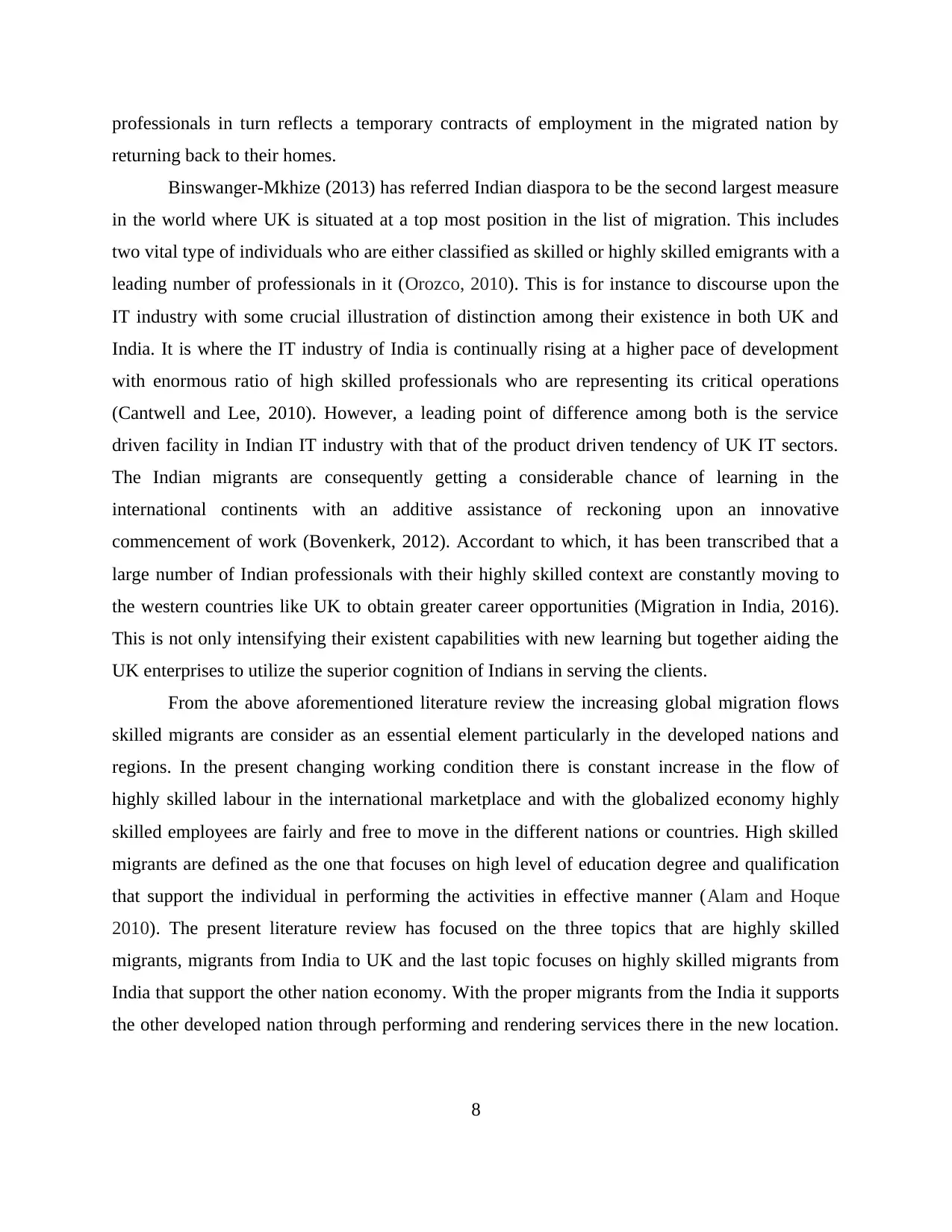
professionals in turn reflects a temporary contracts of employment in the migrated nation by
returning back to their homes.
Binswanger-Mkhize (2013) has referred Indian diaspora to be the second largest measure
in the world where UK is situated at a top most position in the list of migration. This includes
two vital type of individuals who are either classified as skilled or highly skilled emigrants with a
leading number of professionals in it (Orozco, 2010). This is for instance to discourse upon the
IT industry with some crucial illustration of distinction among their existence in both UK and
India. It is where the IT industry of India is continually rising at a higher pace of development
with enormous ratio of high skilled professionals who are representing its critical operations
(Cantwell and Lee, 2010). However, a leading point of difference among both is the service
driven facility in Indian IT industry with that of the product driven tendency of UK IT sectors.
The Indian migrants are consequently getting a considerable chance of learning in the
international continents with an additive assistance of reckoning upon an innovative
commencement of work (Bovenkerk, 2012). Accordant to which, it has been transcribed that a
large number of Indian professionals with their highly skilled context are constantly moving to
the western countries like UK to obtain greater career opportunities (Migration in India, 2016).
This is not only intensifying their existent capabilities with new learning but together aiding the
UK enterprises to utilize the superior cognition of Indians in serving the clients.
From the above aforementioned literature review the increasing global migration flows
skilled migrants are consider as an essential element particularly in the developed nations and
regions. In the present changing working condition there is constant increase in the flow of
highly skilled labour in the international marketplace and with the globalized economy highly
skilled employees are fairly and free to move in the different nations or countries. High skilled
migrants are defined as the one that focuses on high level of education degree and qualification
that support the individual in performing the activities in effective manner (Alam and Hoque
2010). The present literature review has focused on the three topics that are highly skilled
migrants, migrants from India to UK and the last topic focuses on highly skilled migrants from
India that support the other nation economy. With the proper migrants from the India it supports
the other developed nation through performing and rendering services there in the new location.
8
returning back to their homes.
Binswanger-Mkhize (2013) has referred Indian diaspora to be the second largest measure
in the world where UK is situated at a top most position in the list of migration. This includes
two vital type of individuals who are either classified as skilled or highly skilled emigrants with a
leading number of professionals in it (Orozco, 2010). This is for instance to discourse upon the
IT industry with some crucial illustration of distinction among their existence in both UK and
India. It is where the IT industry of India is continually rising at a higher pace of development
with enormous ratio of high skilled professionals who are representing its critical operations
(Cantwell and Lee, 2010). However, a leading point of difference among both is the service
driven facility in Indian IT industry with that of the product driven tendency of UK IT sectors.
The Indian migrants are consequently getting a considerable chance of learning in the
international continents with an additive assistance of reckoning upon an innovative
commencement of work (Bovenkerk, 2012). Accordant to which, it has been transcribed that a
large number of Indian professionals with their highly skilled context are constantly moving to
the western countries like UK to obtain greater career opportunities (Migration in India, 2016).
This is not only intensifying their existent capabilities with new learning but together aiding the
UK enterprises to utilize the superior cognition of Indians in serving the clients.
From the above aforementioned literature review the increasing global migration flows
skilled migrants are consider as an essential element particularly in the developed nations and
regions. In the present changing working condition there is constant increase in the flow of
highly skilled labour in the international marketplace and with the globalized economy highly
skilled employees are fairly and free to move in the different nations or countries. High skilled
migrants are defined as the one that focuses on high level of education degree and qualification
that support the individual in performing the activities in effective manner (Alam and Hoque
2010). The present literature review has focused on the three topics that are highly skilled
migrants, migrants from India to UK and the last topic focuses on highly skilled migrants from
India that support the other nation economy. With the proper migrants from the India it supports
the other developed nation through performing and rendering services there in the new location.
8

Along with this, literature has also assessed in gaining insight knowledge regarding different
trends that assists the moving of highly skilled personnel from the rural to urbanized area.
9
trends that assists the moving of highly skilled personnel from the rural to urbanized area.
9
⊘ This is a preview!⊘
Do you want full access?
Subscribe today to unlock all pages.

Trusted by 1+ million students worldwide
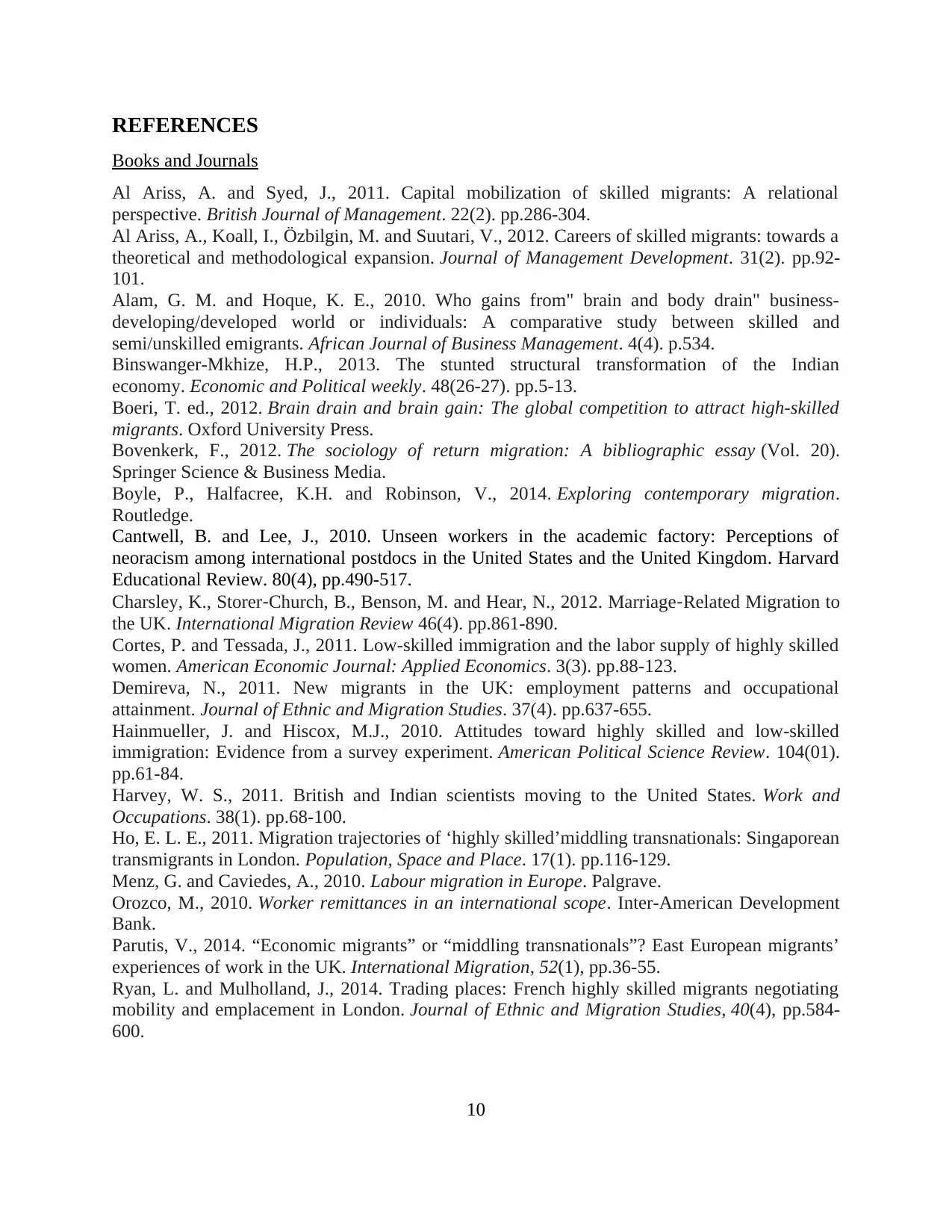
REFERENCES
Books and Journals
Al Ariss, A. and Syed, J., 2011. Capital mobilization of skilled migrants: A relational
perspective. British Journal of Management. 22(2). pp.286-304.
Al Ariss, A., Koall, I., Özbilgin, M. and Suutari, V., 2012. Careers of skilled migrants: towards a
theoretical and methodological expansion. Journal of Management Development. 31(2). pp.92-
101.
Alam, G. M. and Hoque, K. E., 2010. Who gains from" brain and body drain" business-
developing/developed world or individuals: A comparative study between skilled and
semi/unskilled emigrants. African Journal of Business Management. 4(4). p.534.
Binswanger-Mkhize, H.P., 2013. The stunted structural transformation of the Indian
economy. Economic and Political weekly. 48(26-27). pp.5-13.
Boeri, T. ed., 2012. Brain drain and brain gain: The global competition to attract high-skilled
migrants. Oxford University Press.
Bovenkerk, F., 2012. The sociology of return migration: A bibliographic essay (Vol. 20).
Springer Science & Business Media.
Boyle, P., Halfacree, K.H. and Robinson, V., 2014. Exploring contemporary migration.
Routledge.
Cantwell, B. and Lee, J., 2010. Unseen workers in the academic factory: Perceptions of
neoracism among international postdocs in the United States and the United Kingdom. Harvard
Educational Review. 80(4), pp.490-517.
Charsley, K., Storer‐Church, B., Benson, M. and Hear, N., 2012. Marriage‐Related Migration to
the UK. International Migration Review 46(4). pp.861-890.
Cortes, P. and Tessada, J., 2011. Low-skilled immigration and the labor supply of highly skilled
women. American Economic Journal: Applied Economics. 3(3). pp.88-123.
Demireva, N., 2011. New migrants in the UK: employment patterns and occupational
attainment. Journal of Ethnic and Migration Studies. 37(4). pp.637-655.
Hainmueller, J. and Hiscox, M.J., 2010. Attitudes toward highly skilled and low-skilled
immigration: Evidence from a survey experiment. American Political Science Review. 104(01).
pp.61-84.
Harvey, W. S., 2011. British and Indian scientists moving to the United States. Work and
Occupations. 38(1). pp.68-100.
Ho, E. L. E., 2011. Migration trajectories of ‘highly skilled’middling transnationals: Singaporean
transmigrants in London. Population, Space and Place. 17(1). pp.116-129.
Menz, G. and Caviedes, A., 2010. Labour migration in Europe. Palgrave.
Orozco, M., 2010. Worker remittances in an international scope. Inter-American Development
Bank.
Parutis, V., 2014. “Economic migrants” or “middling transnationals”? East European migrants’
experiences of work in the UK. International Migration, 52(1), pp.36-55.
Ryan, L. and Mulholland, J., 2014. Trading places: French highly skilled migrants negotiating
mobility and emplacement in London. Journal of Ethnic and Migration Studies, 40(4), pp.584-
600.
10
Books and Journals
Al Ariss, A. and Syed, J., 2011. Capital mobilization of skilled migrants: A relational
perspective. British Journal of Management. 22(2). pp.286-304.
Al Ariss, A., Koall, I., Özbilgin, M. and Suutari, V., 2012. Careers of skilled migrants: towards a
theoretical and methodological expansion. Journal of Management Development. 31(2). pp.92-
101.
Alam, G. M. and Hoque, K. E., 2010. Who gains from" brain and body drain" business-
developing/developed world or individuals: A comparative study between skilled and
semi/unskilled emigrants. African Journal of Business Management. 4(4). p.534.
Binswanger-Mkhize, H.P., 2013. The stunted structural transformation of the Indian
economy. Economic and Political weekly. 48(26-27). pp.5-13.
Boeri, T. ed., 2012. Brain drain and brain gain: The global competition to attract high-skilled
migrants. Oxford University Press.
Bovenkerk, F., 2012. The sociology of return migration: A bibliographic essay (Vol. 20).
Springer Science & Business Media.
Boyle, P., Halfacree, K.H. and Robinson, V., 2014. Exploring contemporary migration.
Routledge.
Cantwell, B. and Lee, J., 2010. Unseen workers in the academic factory: Perceptions of
neoracism among international postdocs in the United States and the United Kingdom. Harvard
Educational Review. 80(4), pp.490-517.
Charsley, K., Storer‐Church, B., Benson, M. and Hear, N., 2012. Marriage‐Related Migration to
the UK. International Migration Review 46(4). pp.861-890.
Cortes, P. and Tessada, J., 2011. Low-skilled immigration and the labor supply of highly skilled
women. American Economic Journal: Applied Economics. 3(3). pp.88-123.
Demireva, N., 2011. New migrants in the UK: employment patterns and occupational
attainment. Journal of Ethnic and Migration Studies. 37(4). pp.637-655.
Hainmueller, J. and Hiscox, M.J., 2010. Attitudes toward highly skilled and low-skilled
immigration: Evidence from a survey experiment. American Political Science Review. 104(01).
pp.61-84.
Harvey, W. S., 2011. British and Indian scientists moving to the United States. Work and
Occupations. 38(1). pp.68-100.
Ho, E. L. E., 2011. Migration trajectories of ‘highly skilled’middling transnationals: Singaporean
transmigrants in London. Population, Space and Place. 17(1). pp.116-129.
Menz, G. and Caviedes, A., 2010. Labour migration in Europe. Palgrave.
Orozco, M., 2010. Worker remittances in an international scope. Inter-American Development
Bank.
Parutis, V., 2014. “Economic migrants” or “middling transnationals”? East European migrants’
experiences of work in the UK. International Migration, 52(1), pp.36-55.
Ryan, L. and Mulholland, J., 2014. Trading places: French highly skilled migrants negotiating
mobility and emplacement in London. Journal of Ethnic and Migration Studies, 40(4), pp.584-
600.
10
Paraphrase This Document
Need a fresh take? Get an instant paraphrase of this document with our AI Paraphraser
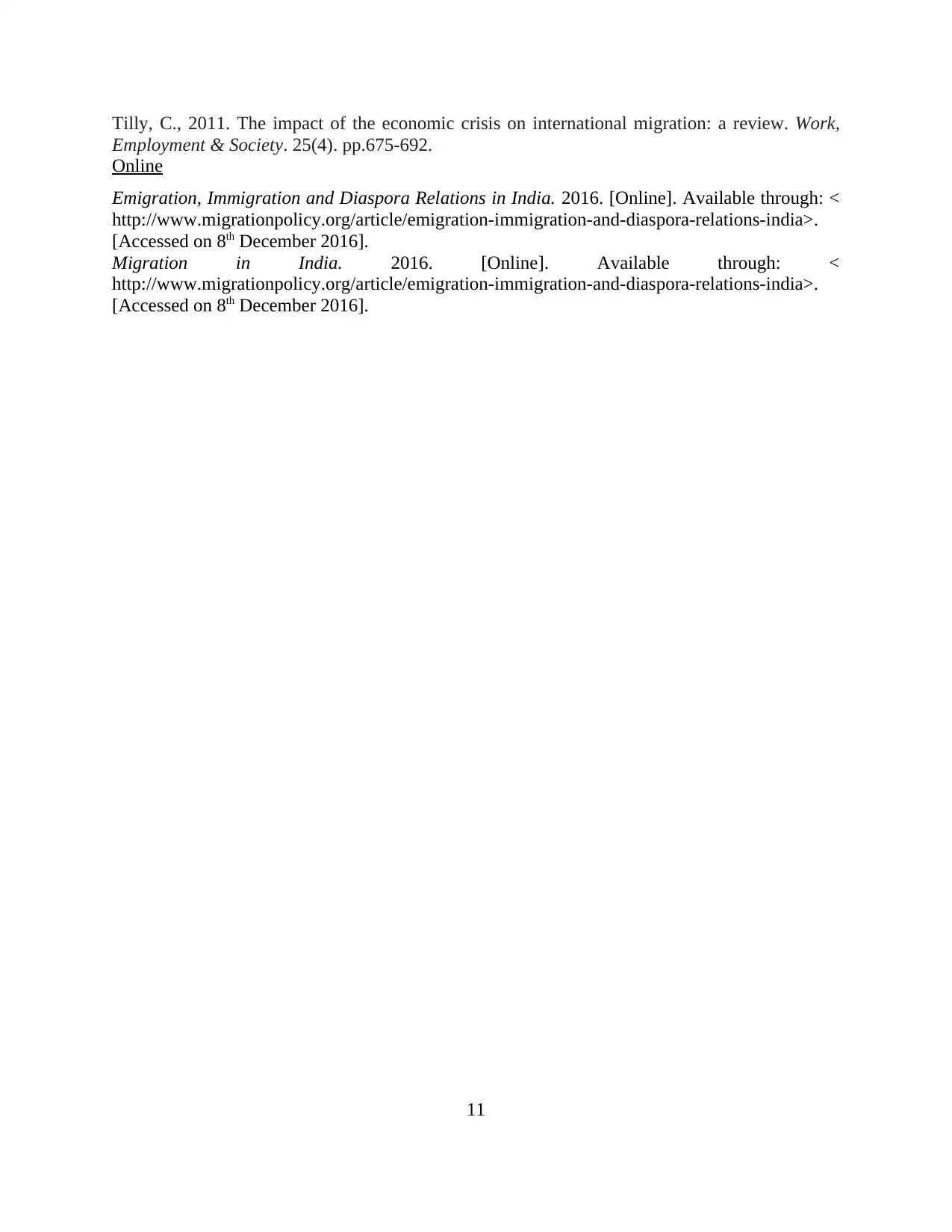
Tilly, C., 2011. The impact of the economic crisis on international migration: a review. Work,
Employment & Society. 25(4). pp.675-692.
Online
Emigration, Immigration and Diaspora Relations in India. 2016. [Online]. Available through: <
http://www.migrationpolicy.org/article/emigration-immigration-and-diaspora-relations-india>.
[Accessed on 8th December 2016].
Migration in India. 2016. [Online]. Available through: <
http://www.migrationpolicy.org/article/emigration-immigration-and-diaspora-relations-india>.
[Accessed on 8th December 2016].
11
Employment & Society. 25(4). pp.675-692.
Online
Emigration, Immigration and Diaspora Relations in India. 2016. [Online]. Available through: <
http://www.migrationpolicy.org/article/emigration-immigration-and-diaspora-relations-india>.
[Accessed on 8th December 2016].
Migration in India. 2016. [Online]. Available through: <
http://www.migrationpolicy.org/article/emigration-immigration-and-diaspora-relations-india>.
[Accessed on 8th December 2016].
11
1 out of 11
Related Documents
Your All-in-One AI-Powered Toolkit for Academic Success.
+13062052269
info@desklib.com
Available 24*7 on WhatsApp / Email
![[object Object]](/_next/static/media/star-bottom.7253800d.svg)
Unlock your academic potential
Copyright © 2020–2025 A2Z Services. All Rights Reserved. Developed and managed by ZUCOL.





